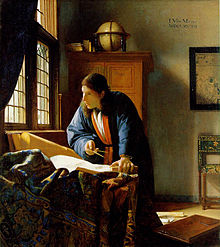Geographer

A geographer is a scholar whose area of study is geography, the study of Earth's natural environment and human society.
Although geographers are historically known as people who make maps, map making is actually the field of study of cartography, a subset of geography. Geographers do not study only the details of the natural environment or human society, but they also study the reciprocal relationship between these two. For example, they study how the natural environment contributes to the human society and how the human society affects the natural environment.
In particular, physical geographers study the natural environment while human geographers study human society. Modern geographers are the primary practitioners of the GIS (geographic information system), who are often employed by local, state, and federal government agencies as well as in the private sector by environmental and engineering firms.
There is a well-known painting by Johannes Vermeer titled The Geographer, which is often linked to Vermeer's The Astronomer. These paintings are both thought to represent the growing influence and rise in prominence of scientific enquiry in Europe at the time of their painting, 1668–69.
Areas of study
| History of geography |
|---|
 |
There are three major fields of study, which are further subdivided:
- Physical geography: including geomorphology, hydrology, glaciology, biogeography, climatology, meteorology, pedology, oceanography, geodesy, and environmental geography.
- Human geography: including Urban geography, cultural geography, economic geography, political geography, historical geography, marketing geography, health geography, and social geography.
- Regional geography: including atmosphere, biosphere, and lithosphere
The National Geographic Society identifies five broad key themes for geographers:
- location
- place
- human-environment interaction
- movement
- regions[1]
See also
- Geography
- Human geography
- List of geographers
- Outline of geography
- Physical geography
- Geographers on Film
References
- ^ "Geography Education @". Nationalgeographic.com. 2008-10-24. Retrieved 2013-07-16.
